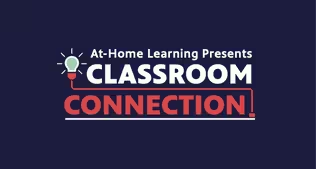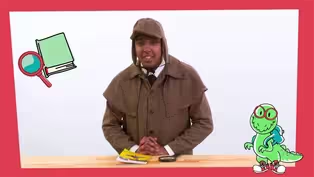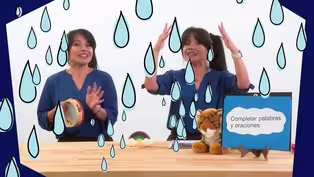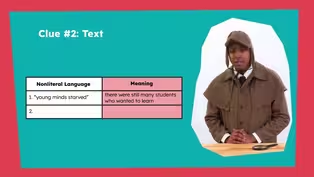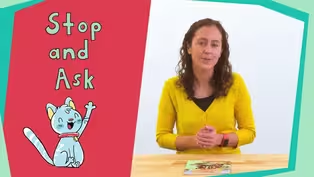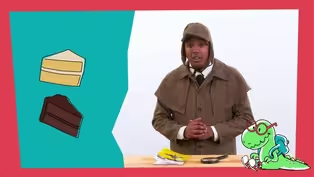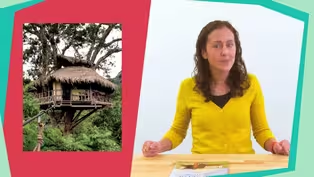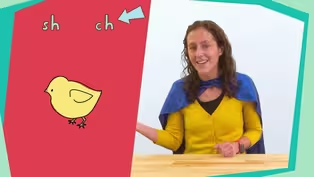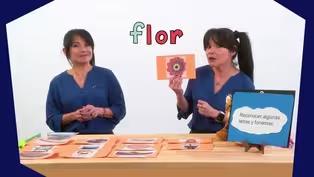
Episode 5 | Literacy Lessons
2/16/2021 | 28m 46sVideo has Closed Captions
Literacy lessons for early learners, led by NC teachers.
The first lesson (aimed at PreK-K learners) helps students understand concepts of print and recognize letter Ii and its sound. The second lesson (aimed at 1st-2nd graders) teaches learners what happens when two vowels are together. Classroom Connection is your At-Home Learning companion where children love to learn. All lessons are led by NC educators.
Problems playing video? | Closed Captioning Feedback
Problems playing video? | Closed Captioning Feedback
At-Home Learning Presents: Classroom Connection is a local public television program presented by PBS NC

Episode 5 | Literacy Lessons
2/16/2021 | 28m 46sVideo has Closed Captions
The first lesson (aimed at PreK-K learners) helps students understand concepts of print and recognize letter Ii and its sound. The second lesson (aimed at 1st-2nd graders) teaches learners what happens when two vowels are together. Classroom Connection is your At-Home Learning companion where children love to learn. All lessons are led by NC educators.
Problems playing video? | Closed Captioning Feedback
How to Watch At-Home Learning Presents: Classroom Connection
At-Home Learning Presents: Classroom Connection is available to stream on pbs.org and the free PBS App, available on iPhone, Apple TV, Android TV, Android smartphones, Amazon Fire TV, Amazon Fire Tablet, Roku, Samsung Smart TV, and Vizio.
Providing Support for PBS.org
Learn Moreabout PBS online sponsorshipMore from This Collection
Video has Closed Captions
Literacy lessons for early learners, led by NC teachers. (28m 46s)
Video has Closed Captions
Literacy lessons for early learners, led by NC teachers. (28m 46s)
Video has Closed Captions
Literacy lessons for early learners, led by NC teachers. (28m 45s)
Video has Closed Captions
Literacy lessons for early learners, led by NC teachers. (28m 45s)
Video has Closed Captions
Literacy lessons for early learners, led by NC teachers. (28m 46s)
Video has Closed Captions
Literacy lessons for early learners, led by NC teachers. (28m 46s)
Video has Closed Captions
Literacy lessons for early learners, led by NC teachers. (28m 45s)
Video has Closed Captions
Short Description: Literacy lessons for early learners, led by NC teachers. (28m 45s)
Video has Closed Captions
Literacy lessons for early learners, led by NC teachers. (28m 45s)
Video has Closed Captions
Literacy lessons for early learners, led by NC teachers. (28m 45s)
Video has Closed Captions
Literacy lessons for early learners, led by NC teachers. (28m 45s)
Video has Closed Captions
Literacy lessons for early learners, led by NC teachers. (28m 45s)
Providing Support for PBS.org
Learn Moreabout PBS online sponsorship[cheerful upbeat music] ♪ - [rapping] ♪ Hey, my name is Mister R ♪ ♪ and I came to say ♪ ♪ I love Classroom Connection in a major way.
♪ Wassup up my super learners and welcome to another day to do some super learning.
How's everybody doin'?
Let's see them thumbs up.
There it is.
I like to see that.
Now what's the best thing you can do while inside?
Learn something cool with that super learning mind.
Yo, check this out.
- Hello, Super Learners.
My name is Miss Jennifer, and I am so excited that you were here to learn with me today.
You will need a piece of paper, a pencil and a stuffed animal for today's lesson.
Ask a trusted adult to help you find these items.
While you're getting your supplies.
I'm gonna grab mine.
I'll be right back.
[bright upbeat music] ♪ Okay.
I'm back now.
And I see you are too.
We have our supplies so let's go.
Today, we are going to read a story about a mother pig who can't find her piglets.
We will review the parts of a book, review the letters P and G and learn the letter I.
We will also learn about some animals.
Let's get started.
The last time we were together we used a circle map to help us think about the letter P and some words that begin with the puh sound.
We named pepperoni pizza, puppy, paintbrush, and pickle.
We also use the circle map to think about the letter G and some words that begin with the guh sound.
We named grapes, gate, and green grass.
Now, we are going to learn about the letter I.
The letter I looks like this.
We write it by starting at the top and making a straight line down.
Then we jumped back to the top and make a straight line that goes from left to right.
Then we're gonna jump down to the bottom and make another line that goes from left to right.
Let's all get out our magic finger and write the letter I in the air.
Start at the top, make a straight line down, then jump back to the top and make a straight line that goes from left to right then jumped down to the bottom and make another line from left to right.
The letter I makes the sound ih.
Say it to your stuffed friend.
Ih, ih, ihh.
Now turn and say it to me.
Ih.
Good job saying the ih sound.
We're going to use a graphic organizer called a circle map to help us think about the letter I and the things that begin with its sound, ih.
You can make your own circle map using a piece of paper and a pencil or crayons.
First, you draw a small circle on your map.
Then, you're going to write what you're think-- what we're thinking about in the small circle.
Today, we're thinking about the letter I, so we should write the letter I in the small circle.
So again, start at the top, make our straight line down, then go back to the top, make our line from left to right, then at the bottom, make another line from left to right.
Then we're going to draw our big circle around our small circle.
Now, you have a circle map.
Super Learners, I need your help so that we can fill in the circle map with things that begin with the sound ih.
I will give you a clue and you try to guess what I'm thinking of.
Are you ready?
Great!
I am thinking of an animal that is only one inch long.
It moves by sliding its body together and stretching it back out.
Can you tell your stuffed friend?
What I am thinking of?
Did you say inchworm?
That's right, great thinking.
Can you show your stuffed friend how to move like an inchworm?
Now, I'm gonna write the word inchworm on the circle map.
Hmm, Inchworm What is the first sound in the word inchworm?
That's right, ih!
Which letter do we need to spell that sound?
That's right, we spell the sound ih with the letter I then we need N, C, H, W, O, R, M, that spells inchworm.
Now, I am thinking of an animal that lives in trees.
It is green and eats plants.
Can you tell your stuffed friend what I'm thinking of?
Did you say iguana?
That's right, great thinking!
Can you show your friend how to eat plants like an iguana?
[munching] Now, I am gonna write the word iguana on the circle map.
Hmmm, Iguana, What is the first sound in the word iguana?
That's right, ih!
Which letter do we need to spell that sound?
That's right, we spell the sound ih with the letter I.
Then, we need G, U, A, N, A, that spells iguana.
Wow, Super Learners!
Our circle map looks great!
Look at those I words we know.
Thanks for helping.
Now, let's get ready to read our book.
Here is our book.
It is titled Little Piglets.
A book has several parts.
This part is called the front cover.
It has the title, tells the author and illustrator and has a picture to show us what the story is about.
This is the back cover.
When we open our book, the very first page we come to is called the title page.
We called this page the title page because it has the title on it.
Tell your friend what is a title page?
Say the title is the name of the book.
Do you see the title?
Right.
Look at me and say the title is the name of the book.
In this story, Mother Pig has lost her piglets.
I remember when I lost my favorite purple pen, I looked everywhere.
I was so sad when I couldn't find it.
Then, I went to write in my notebook and there it was, I was so happy.
Have you ever lost anything?
What happened when you lost it?
How did you feel when you couldn't find it?
How did you feel when you found it?
Tell your stuffed friend what happened when you lost something?
Oh, wow!
Now, let's turn our page and see what happens when Mother Pig can't find her piglets.
As we are reading, let's count the animals we see in the story.
Where are my piglets?
Says Mother Pig.
I will look for them.
Mother Pig looks by the pond.
She sees little ducklings.
Let's count them.
One, two, three, but her little piglets are not there.
Mother Pig looks by the house.
She sees little chicks.
Let's count them.
One, two, three, but her piglets are not there.
Mother Pig looks by the gate.
She sees little lambs.
Let's count them.
One, two, but her little piglets are not there.
Mother Pig looks by the barn.
She sees little kittens.
Let's count them.
One, two, three, but her little piglets are not there.
Then, Mother Pig sees five little pink tails and Mother Pigs sees her little piglets.
Let's count them.
One, two, three, four, five.
That's great!
I am so glad that Mother Pig found her piglets.
Are you?
Wow, we counted a lot of little animals.
Tell your stuffed friend how many animals you counted.
Great counting!
All right, Super Learners.
That is the end of our lesson for today.
Thank you so much for being with me.
As we reviewed the letters P and G and learned about the letter I. I hope you enjoyed the story about Mother Pig in her search for her piglets.
Keep looking for words that begin with the letters P, I, and G. When you find new P, I, or, G words, add them to your circle maps.
I'll see you next time.
- Heyyy everybody.
That was awesome.
I bet you know something now that you didn't know yesterday.
When you use your beautiful brain, it helps you understand more about the world we live in.
Just like eating your veggies helps you grow strong, practicing your reading helps your brain get big and strong too.
[whimsical music] Hi, my name is Bianca.
I'm gonna read Bad Frogs.
Bad Frogs, green and slimy, [frog ribbits] riding motorbikes, slurping ice cream.
[motorbike revving] Making bad noises at the dinner table.
[burp] Bad frogs, very bad frogs.
Bad frogs smelling yucky, talking crummy.
Wearing bad hats, wearing dark glasses.
Staying up late, kissing their girlfriends.
[whistle] [kissing] Bad frogs, very bad frogs.
[car horn] Bad frogs, riding skateboards, chewing newt gum.
[bubble gum pops] Spilling the water out of the bathtub.
[frog ribbits] [water splashes] Bad frogs, very bad frogs.
Could they be good?
Could they be quiet?
Could they dress up in tutus and dance in a straight line?
Could they?
Oh, would they?
No way!
Not a chance.
They'll never say thank you.
They'll never say please.
They'll never eat broccoli.
They'll never ever, ever eat peas.
They'll jump in the mud.
They'll fall on their heads.
[downward spiral] [splash] They'll fight with their toothbrushes.
They'll fall out of bed.
They'll be... Bad frogs forever!
The end.
[upbeat sound] - Hello, Readers.
My name is Miss Gary, and I'm so excited to be learning with you today.
Before we get started with our learning lesson, let's say hello with our welcome song.
[cat meows] ♪ Hello readers.
♪ ♪ Hello readers.
♪ ♪ How are you?
♪ ♪ How are you?
♪ ♪ I'm so glad to see you.
♪ ♪ I'm so glad to teach you.
♪ ♪ Hello you, ♪ ♪ you and you.
♪ So let's take a look at this anchor chart.
These letters are called vowels.
Each one may make a short vowel sound and a long vowel sound.
So let's review our short and long vowel sounds.
So I love to move.
So we're going to learn and review our long and short vowel sounds.
I'm gonna crouch down when I say a short vowel sound and stand up when I say a long vowel sound.
So let's do that together.
Stand up for me and get ready, Readers.
Here comes the A.
Short A says, ah, and long A says, ay.
Here comes E. The short E says, eh and the long E says, ee.
Next is I.
Short I, ih.
Long I, eye.
Next is O.
The short O vowel sound says, awe.
And the long vowel O says, oh... and here's the U.
Short U says, uh, and the long U says, you.
Wow, Readers.
That was great.
We will find these vowels in every word that we read and write.
But in addition to knowing our long and short vowel letter sounds during each lesson, we're going to learn some special words.
The words have special names, and they're called heart words.
And we call these word heart words because we're practicing reading them so that we know them by heart or so we won't have to sound them out.
To do this, we're going to create our very own heart word dictionary.
You're going to need two pieces of paper and something to write with.
While I grab mine, you go ahead and get yours.
[bright upbeat music] ♪ I'm back readers, with my two pieces of paper and something to write with.
I grabbed a marker, but it's okay if you grabbed a pen or pencil or crayon.
So, let's make our heart dictionary together.
I'm going to start by stacking my two pieces of paper on top of each other, just like this.
Now, I'm going to fold them in half, hamburger style or the short way.
Wow, look at that, Readers.
It's a book.
But, we're going to draw a heart on the cover of our heart word dictionary, so that we know we're putting our heart words there.
Now we're ready, so let's read our first heart word.
Look at this word.
This is the word could.
Can you say could?
Good, now let's spell it.
C, O, U, L, D. Could.
Let's say it one more time, Could.
Now, we're going to write it on the first page of our heart word dictionary.
Let's write it.
C, O, U, L, D. Could.
There's mine.
Great job, let's get ready for our second heart word.
Look at this word, Readers.
This is the word away.
Can you say away?
Good.
Now let's spell it.
A, W, A, Y.
Away.
Let's say it one more time.
Away.
Now we're going to write this heart word on the second page of our heart word dictionary.
A, W, A, Y.
Away.
Great job, Readers.
We're going to learn one more heart word for our dictionary.
Let's look at this word.
This is the word they.
Can you say they?
Good.
Now, let's spell it.
T, H, E, Y.
They.
Let's say it one more time.
They.
Now we're going to write our final heart word on the third page of our dictionary.
T, H, E, Y.
They.
Excellent work, Readers.
Later today, you could share your heart word dictionary with someone you love or show them how you read it.
In today's lesson, we're going to learn about how vowels work together on a team, and that some of the time, when vowels work together, side by side, only the first vowel says it's letter name, like here.
So when two vowels go walking, the first one does the talking.
So to help us learn about how vowel teams work together, in words, let's look at some of our most common vowel teams that we see in words.
Let's look at this vowel team.
E, A.
Listen to me say this word, beach.
Let's tap out the sounds we hear in the word beach.
Buh, eee, ch.
What sound did you hear this vowel team say?
Normally, when we see the E and the A, they say the sounds, eh and ah separately, but together when we see them, sometimes they'll say the long sound E. So when two vowels are together, like E and A in the word beach, the first vowel is doing all of the talking.
So, when I see E, A together, what sound will it say?
E. Can we build some more words that have the E, A vowel team sound?
We put a R at the beginning.
Let's read this word, reach.
What sound did you hear the E, A say?
E, so this word is reach.
Now, let's look at our next E, A vowel team word.
The D, R at the beginning of our word, that's a blend.
So when we read that sound, we're going to go duh, ruu, and blend the sound together.
There's the E. And our final sound is mmm, so when I read it together, dr- ea- m. Dream.
Now, let's look at another pair of vowels that make the same E sound.
Let's read this word.
This is the word keep.
I'll point to the letters, and you say the sounds with me as I point.
K- ee- p. Keep.
The letter K makes the kuh sound, the E, E vowel team makes the long E sound, and the P makes the puh sound.
The E, E vowel team when they're together is going to say long E. E. Can you say that?
Good.
Let's look at our next word with our E, E vowel team.
This is a diagraph.
So when we see it, it goes th, at the end of our word.
So let's read it together.
T- ee- th.
Teeth.
This word is teeth.
The E, E together make the long E sound.
Let's read one more.
My S, L is a blend, so when I read it, it'll sound like this, sssl.
Let's read this word, sl- ee- p. Sleep.
That's the word sleep.
So they E, E together.
That vowel team says E. Let's look at another vowel team.
This is the vowel team A, I.
Together, they're going to make the long A sound, ay.
let's look at a couple of words that go with this vowel team.
This is the word rain.
R- ai- n. And I can change that beginning sound out to tr, and it will read, tr- ai- n. So we're going to take a look at just a couple more words that go with the vowel teams, A, Y, O, A and I, E. So let's look at our vowel team A, Y.
This vowel team when they're together, they're going to say ay, so let's build a word.
What word do we have?
This is the word play.
If I tapped out the sounds that the letters make in the word play, I would hear, p- l- ay.
Play.
I can change my beginning sound with the sound duh, or the letter D and make the word, day.
So when we see this vowel team appear in words, most of the time at the end of the word it's going to make the long A sound.
Let's look at another one, Readers.
This vowel team is the I, E. Do you remember what sound it says?
Good.
It says the long I sound.
So let's sound out this word.
Lie, like it's not good to tell a lie.
So readers, good job decoding some of our words that have vowel teams in them.
You did an awesome job today learning about vowel teams and how, when two vowels are side by side, the first vowel almost always says the letter name.
So I hope you enjoyed this lesson today and I'll see you again next time.
- Wait a second, wait a second.
Drop everything you're doing and check out this super cool video.
Hi, I'm Miss Raven, and we are going to be stretching our arms.
We stretch our arms so that we're nice and limber and ready for any type of movement.
We're gonna start by pulling our right arm to the left side with our left arm covering our right.
And hold.
[peppy electronic music] ♪ We open up and switch arms.
♪ Next, we're going to reach out with our right, bend at the elbow, and pull with our left.
♪ And switch, we're gonna reach up with our left, bend at the elbow and pull with our right.
♪ Awesome.
Now we're gonna make big arm circles going back.
And big arm circles moving forward.
♪ We're gonna open up as wide as we can with our arms and give ourselves a big hug.
♪ And we'll do the same on the other side.
♪ Awesome.
Thank you for stretching with me.
- Wow.
Can you believe how much we learned today?
I'm so grateful you were here and I know you'll have fun next time.
Thanks for stopping by wishing you peace, love, and learning.
[cheerful upbeat music] ♪
Support for PBS provided by:
At-Home Learning Presents: Classroom Connection is a local public television program presented by PBS NC
